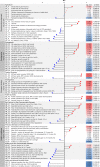Covariation of the incidence of type 1 diabetes with country characteristics available in public databases
- PMID: 25706995
- PMCID: PMC4338253
- DOI: 10.1371/journal.pone.0118298
Covariation of the incidence of type 1 diabetes with country characteristics available in public databases
Abstract
Background: The incidence of Type 1 Diabetes (T1D) in children varies dramatically between countries. Part of the explanation must be sought in environmental factors. Increasingly, public databases provide information on country-to-country environmental differences.
Methods: Information on the incidence of T1D and country characteristics were searched for in the 194 World Health Organization (WHO) member countries. T1D incidence was extracted from a systematic literature review of all papers published between 1975 and 2014, including the 2013 update from the International Diabetes Federation. The information on country characteristics was searched in public databases. We considered all indicators with a plausible relation with T1D and those previously reported as correlated with T1D, and for which there was less than 5% missing values. This yielded 77 indicators. Four domains were explored: Climate and environment, Demography, Economy, and Health Conditions. Bonferroni correction to correct false discovery rate (FDR) was used in bivariate analyses. Stepwise multiple regressions, served to identify independent predictors of the geographical variation of T1D.
Findings: T1D incidence was estimated for 80 WHO countries. Forty-one significant correlations between T1D and the selected indicators were found. Stepwise Multiple Linear Regressions performed in the four explored domains indicated that the percentages of variance explained by the indicators were respectively 35% for Climate and environment, 33% for Demography, 45% for Economy, and 46% for Health conditions, and 51% in the Final model, where all variables selected by domain were considered. Significant environmental predictors of the country-to-country variation of T1D incidence included UV radiation, number of mobile cellular subscriptions in the country, health expenditure per capita, hepatitis B immunization and mean body mass index (BMI).
Conclusions: The increasing availability of public databases providing information in all global environmental domains should allow new analyses to identify further geographical, behavioral, social and economic factors, or indicators that point to latent causal factors of T1D.
Conflict of interest statement
Figures



Similar articles
-
Correlating the global increase in type 1 diabetes incidence across age groups with national economic prosperity: A systematic review.World J Diabetes. 2019 Dec 15;10(12):560-580. doi: 10.4239/wjd.v10.i12.560. World J Diabetes. 2019. PMID: 31915518 Free PMC article.
-
Incidence and trend of type 1 diabetes and the underlying environmental determinants.Diabetes Metab Res Rev. 2019 Jan;35(1):e3075. doi: 10.1002/dmrr.3075. Epub 2018 Oct 11. Diabetes Metab Res Rev. 2019. PMID: 30207035 Review.
-
The socioeconomic correlates of global complication prevalence in type 1 diabetes (T1D): a multinational comparison.Diabetes Res Clin Pract. 2005 Nov;70(2):143-50. doi: 10.1016/j.diabres.2005.03.026. Epub 2005 Apr 25. Diabetes Res Clin Pract. 2005. PMID: 16188576
-
Geographical variation in the incidence of type 1 diabetes in the Nordic countries: A study within NordicDiabKids.Pediatr Diabetes. 2020 Mar;21(2):259-265. doi: 10.1111/pedi.12943. Epub 2019 Nov 17. Pediatr Diabetes. 2020. PMID: 31702838
-
The T1D Index: Implications of Initial Results, Data Limitations, and Future Development.Curr Diab Rep. 2023 Oct;23(10):277-291. doi: 10.1007/s11892-023-01520-4. Epub 2023 Aug 23. Curr Diab Rep. 2023. PMID: 37610700 Free PMC article. Review.
Cited by
-
Incidence trend of type 1 diabetes mellitus in Serbia.BMC Endocr Disord. 2020 Mar 9;20(1):34. doi: 10.1186/s12902-020-0504-y. BMC Endocr Disord. 2020. PMID: 32151244 Free PMC article.
-
Type 1 diabetes loci display a variety of native American and African ancestries in diseased individuals from Northwest Colombia.World J Diabetes. 2019 Nov 15;10(11):534-545. doi: 10.4239/wjd.v10.i11.534. World J Diabetes. 2019. PMID: 31798789 Free PMC article.
-
Birth Order, Caesarean Section, or Daycare Attendance in Relation to Child- and Adult-Onset Type 1 Diabetes: Results from the German National Cohort.Int J Environ Res Public Health. 2022 Aug 31;19(17):10880. doi: 10.3390/ijerph191710880. Int J Environ Res Public Health. 2022. PMID: 36078596 Free PMC article.
-
Global epidemiology of type 1 diabetes in young adults and adults: a systematic review.BMC Public Health. 2015 Mar 17;15:255. doi: 10.1186/s12889-015-1591-y. BMC Public Health. 2015. PMID: 25849566 Free PMC article.
-
Correlating the global increase in type 1 diabetes incidence across age groups with national economic prosperity: A systematic review.World J Diabetes. 2019 Dec 15;10(12):560-580. doi: 10.4239/wjd.v10.i12.560. World J Diabetes. 2019. PMID: 31915518 Free PMC article.
References
-
- Ogle GD, Lesley J, Sine P, McMaster P. Type 1 diabetes mellitus in children in Papua New Guinea. P N G Med J. 2001;44(3–4):96–100. - PubMed
-
- Frongia O, Mastinu F, Sechi GM. Prevalence and 4-year incidence of insulin-dependent diabetes mellitus in the province of Oristano (Sardinia, Italy). Acta Diabetol. 1997;34(3):199–205. - PubMed
-
- Garancini P, Gallus G, Calori G, Formigaro F, Micossi P. Incidence and prevalence rates of diabetes mellitus in Italy from routine data: a methodological assessment. Eur J Epidemiol. 1991;7(1):55–63. - PubMed
Publication types
MeSH terms
LinkOut - more resources
Full Text Sources
Other Literature Sources
Medical

